COVER- Can this car save the world? Oliver Kuttner's betting on it
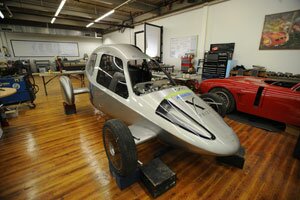
Because they were designed from scratch and are painstakingly built by hand, each of the four Very Light Cars has cost "more than any luxury sedan to build," says Kuttner, declining to give an exact figure. Once they are mass produced, he says, the retail cost should be under $20,000.
JEN FARIELLO
The hulking white warehouse looks like any other industrial building in any other industrial town– there's no sign or marking, nothing to hint that a solution to America's oil dependency might lie just a few steps inside, where rough, weatherstained concrete suddenly gives way to a modern 22,000 square foot workshop with gleaming hardwood floors and a variety of high tech machines. Here, tucked away on Kemper Street in Lynchburg, nearly a dozen men– some of the world's top auto mechanics and engineers– are working furiously on an automobile prototype that they believe could avert the country's energy crisis and might even prevent another environmental catastrophe like the BP spill.
Sleek and narrow with a bullet-shaped nose and tail and four wheels set apart from the chassis, the prototype they're building by hand is named the Very Light Car, and appropriately so. At less than 725 pounds, it's about one fourth the weight of a Mini Cooper. If these men achieve what they've set out to do, the Very Light Car will be the first of its kind: a car that gets 100 miles per gallon while meeting all federal and state safety and emission standards, and which can be mass produced and sold for less than $20,000.
They'll also have won $10 million in an international contest known as the Progressive Automotive X Prize that pits dozens of teams from around the world against each other in a race to build the car of the future.
And they will have made one Charlottesville man very, very happy.
Location, location, location
If a warehouse in Lynchburg seems an unlikely location for such a cutting edge project, one only need mention the name Oliver Kuttner, and it might just start to make sense.
"He doesn't think like other people," laughs former Charlottesville Mayor and current City Councilor David Brown, who watched Kuttner tangle with the City of Charlottesville over various development projects in the last decade but admired Kuttner's car idea to such an extent he's now on the payroll, commuting to Lynchburg several days a week and doing PR for the new company.
Indeed, Kuttner may be best known locally for his creative if bureaucrat-maddening approach to building and renovating downtown buildings. The subject of a February 2005 Hook cover story, "No More Mr. Bad Boy," Kuttner famously announced his decision to abandon all future building projects in Charlottesville citing his frustration with red tape and his inability to work creatively.
"It's such a process," he said of his many battles with city officials over projects including the multi-facaded, Mall-fronting Terraces and the Downtown Tire building a few blocks west on Water Street. "It's like wasting money for nothing."
He took his money south to Lynchburg, where over the course of the next four years, he would purchase nearly a million square feet of commercial space at a fraction of the cost of Charlottesville real estate and develop much of it, praising city officials there as "much easier to work with."
In 2007, as gas prices soared, the economy tanked, and the war in Iraq raged, Kuttner– a race-car driver who once owned the Pantops-area Porsche dealership– started thinking about the solution to what may be this country's greatest crisis, and something he worries could lead to its downfall: our addiction to oil.
When the Progressive Automobile X Prize was announced in 2007 with the challenge of creating an ultra fuel-efficient, safe vehicle that could be mass marketed, Kuttner's competitive and entrepreneurial spirit was provoked. He would soon plunge what he describes as a "large percentage" of his own personal net worth into the company called Edison2 with a single minded certainty.
"I knew we could win this," he says.
The A-Team
Kuttner had vision and drive, but he concedes that he didn't possess the technical acumen to build the car of the future. Fortunately, from his years racing Formula One cars, he knew a lot of experts. First on his list: an Englishman living in Indianapolis named Ron Mathis, a mechanical engineer who has designed winning race cars. Nearing his 50th birthday and thinking about his legacy, Mathis says, Kuttner's call came at an opportune time.
"I've built cars that go fast, but this project could change the entire game," says Mathis, a soft-spoken bearded man whose eyes light up as he talks about the Very Light Car. As the competition enters the home stretch, Mathis now gets home to his wife in Indianapolis only once a month.
During their initial brainstorming sessions, Kuttner says, the two men assumed that the only type of car that could win the X Prize would be electric, a hybrid or the much hyped hydrogen fuel cell. But as they conducted early research, the limitations of each quickly became clear: the cars themselves may run cleaner, they realized, but the energy they require relies on some not-so-clean processes.
Lithium batteries, for instance, require metallic lithium– something that doesn't occur naturally, says UVA physics professor Lou Bloomfield, author of How Things Work and the website howeverythingworks.com.
"You can find lithium salts, then separate atoms so you end up with lithium metal," says Bloomfield. But that process, he points out, consumes more energy than the battery will ever produce– from the mining of the lithium to the repeated charging of the eventual batteries. "Where'd that energy come from?" he asks. "If it comes from fossil fuels, you basically didn't do anything."
As for hydrogen, Bloomfield says, the limitations are daunting because the element exists as a gas at atmospheric pressure. So in order to have enough to power a car, you'd either have to carry a building-sized tank along or figure out a way to store it under pressure in liquid form, requiring a temperature as low as minus 250 degrees Celsius.
"It's not going to work for a vehicle," Bloomfield concludes.
Kuttner and Mathis quickly came to the same conclusions.
"We gave up all preconceived notions," says Kuttner. "We had to start entirely from scratch."
The solution they eventually arrived at, he says, might at first seem counterintuitive: stick with oil.
A spill
As the most catastrophic oil spill in this country's and perhaps the world's history continues to poison the Gulf of Mexico, with plumes reaching waters far beyond and globs of crude washing ashore, it seems almost blasphemous to speak out in support of fossil fuels. After all, they are the substance whose widespread use is blamed for global warming not to mention the heartbreaking and enraging images of oil-soaked birds and dead dolphins that are now a staple of daily news. But Kuttner– ever the contrarian– says demonizing oil may be the wrong tack if the goal is an immediate reduction in consumption and emissions via a product that could be quickly rolled out to the public.
"You need a 500-pound battery to harness the energy you get out of one gallon of gasoline," says Kuttner, adding that because batteries require repeated charging, "you still haven't freed yourself from fossil fuels."
But a car that uses a fraction of the gasoline of a traditional car and that burns cleaner than any other car currently on the road, he and Mathis hypothesized, could at the very least quickly end dependence on foreign oil– the basis for our wars in the Middle East, many argue– and could buy us time for truly clean renewable energy sources such as wind and solar to be developed in sufficient quantities to replace fossil fuels.
"A hundred years from now, we're not going to be mining for anything," says Bloomfield. "But we're not there yet."
With their new goal in mind, Kuttner and Mathis– who named the company Edison2 while still thinking they'd be building an electric vehicle– lined up several investors, then put together an elite team of mechanics, machinists, engineers, and drivers from the world of racing.
To accomplish their plan, they set out to build something from scratch– every piece of the car down to the nuts and bolts would need to be imagined and then created by hand out of lightweight materials such as aluminum, before being painstakingly put together by highly trained mechanics accustomed to working on Ferraris, Audis, and other high performance vehicles.
"This," Mathis says, smiling and looking around the windowless space at the cars in various states of repair, "is the Wild West of engineering."
The sharply declining economy in 2008 hit the racing industry, and sponsorships for various teams dried up leaving mechanics and engineers unemployed. Bad news for those teams, however, was good news for Kuttner, who found some of his top picks free and eager to come work for him in Lynchburg, inspired by the possibility of the acclaim and prestige that would come from an X Prize win– but even more so by the idea that through their expertise, they'd be leaving a lasting and positive mark on the world.
"This means something to all of us," says Kuttner. "These guys are passionate."
Kuttner himself says his own motivation has shifted. "When I started out, I just wanted to win," he says with a smile. "Now, I see the good this could do, and whether we win or not, we won't stop."
Of course, winning is no simple challenge.
The contest
The mission of the nonprofit X Prize Foundation is simple: "to create radical breakthroughs for the benefit of humanity thereby inspiring the formation of new industries, jobs and the revitalization of markets that are currently stuck."
The first X Prize was announced back in 1996 with the challenge of taking passengers to space without NASA's help. It took eight years, but on September 29, 2004, SpaceShipOne, a craft sponsored by Microsoft cofounder Paul Allen, beat 20 other teams when it was piloted into orbit nearly 70 miles above the earth for the second time to win the $10 million prize– less than half of the reported $25 million cost of building it.
This time around, the challenge is more earthbound, but the potential impact, one might argue, is far higher. The competition and prize money is divided into three categories– $5 million for a four seater vehicle class, and $2.5 million for each of the two two-seater categories– side-by-side and front-and-back). Initially, there were 111 teams competing, but the judges have trimmed the pool to 22 cars, with Edison2 the only company still alive and competing in all three categories– an accomplishment achieved by installing the seats in the three different configurations.
The on-track judging phase of the competition officially kicked off in April at a Michigan International Speedway, where each vehicle was put through a series of tests for safety, acceleration, braking, and emergency maneuvers.
While safety in such a light vehicle might concern some would-be buyers, Kuttner says the VLC's diamond shape deflects most head-on collisions.
"You'd walk away from some wrecks in this car that you wouldn't survive in a standard car," he says. A steel frame strengthens the cabin, and even the wheels provide unexpected safety features: first, because they are separate from the chassis, they don't transfer collision impact to the passenger cabin as happens in traditional cars. Additionally, in a side-impact collision, the position of the wheels provides 18 inches of impact absorption before the cabin would be struck. "That makes a big difference," says Kuttner.
The car's sophisticated aerodynamics mean it will cling to the road, not be lifted by underdrafts, and it will be equipped with the same seatbelts and airbags required in a standard vehicle.
Edison2's four Very Light Cars are among 22 vehicles that survived the latest cut, but if the surviving group still seems large, professional journalists have taken notice of the team from Lynchburg.
"They were one of the standout performers," says Jason Fagone, covering the X Prize for Wired magazine and and writing a book on the competition through Random House.
Fagone has visited the Edison2 workshop several times and says he's impressed by the company as a whole and by Kuttner's dedication.
"He's fearless and totally committed to the car," Fagone says, noting the personal financial risk Kuttner is taking.
Kuttner declines to give the exact amount of money he and four investors– who he says decline to be named– have in the company, saying only it's "millions" and that if Edison2 doesn't win, he will have to sell his real estate assets and will lose "half my retirement."
"He has put his whole life on the line for it," says Fagone. "He believes so strongly, and that sort of energy and commitment is always going to be appealing."
Ronald Ahrens, covering the event for Car & Driver magazine and on his website baggyparagraphs.com, calls the Very Light Car one of his favorites thanks to its design.
"If you have that sensibility that some of us have about minimalist and lightweight, you see this thing and you go, 'Wow, finally someone built this car!' No one ever had a reason to build a car like this before."
Admiration from journalists and car afficionados aside, there's no guarantee Edison2 will win even one of its categories, never mind all three. After all, there are still plenty of other teams with the same dream, if a different idea of how to achieve it.
Among those teams are a group of Philadelphia inner city high school students who have built a hybrid, an already established electric car company called Zap, and a group from Cornell University whose car runs on diesel. There are teams from Thailand, Switzerland, the UK, and Finland.
Kuttner, however, remains confident that the Very Light Cars driven by Indy car driver and Edison2 engineer Brad Jaeger and famed Italian driver Emanuele Pirro, a five-time winner of the 24 Hours of Le Mans race, will remain on top through the next two competition phases– the 10-day Knockout phase beginning June 20, in which cars must get 67 mpg, and the Finals phase in late July, when the 100 mpg goal must be reached. The official X Prize website predicts eight to 10 vehicles will clear the finals and a winner in each category will be announced in September after a period of validating results in a laboratory.
"We like our chances," says Kuttner, shrugging and noting that a recent laboratory test run showed the Very Light Car– which actually runs on a biofuel called E85 that contains ethanol and is only 15 percent gasoline– getting more than 106 miles to the gallon in the highway cycle with the emissions meeting the far more stringent standards currently set for 2014. "We've had contact with some very, very influential parties in the automobile industry," says Kuttner, who notes that a recently scheduled meeting with U.S. Secretary of Energy Steven Chu had to be rescheduled due to the BP spill.
Journalist Fagone calls Edison2 a "front runner," but he points out that Kuttner isn't the only X Prize competitor to display such confidence or put on a strong show.
"They're all convinced that they're correct. They have to be, putting in so much time and money," he says. "They make major sacrifices."
Of course, so are the potential rewards– not only for the winning teams, but for us all. But will Americans really be willing to switch over to a different kind of vehicle, one that potentially looks radically different than cars on the road today?
UVA's Bloomfield is pessimistic about the chances, saying he sees neither the "political will" among the nation's leaders nor a willingness among the population to make the kinds of changes that could end up solving the energy crisis.
"Even disasters don't seem to get us motivated," says Bloomfield. "We're so resistant as a society to any sacrifice– the tiniest sacrifice, we won't do it. It takes an extreme crisis to drive us toward any meaningful change."
Kuttner, however, says he believes Americans are ready for and will embrace a different kind of car, particularly if they can afford it and it doesn't require unnecessary sacrifice.
"If you had an electric car," a grinning Kuttner tells a reporter who has just made the hilly trek south from Charlottesville to Lynchburg, "you wouldn't have been able to come down here to do this story."
He's also encouraged that the Obama administration has taken significant steps to improve fuel efficiency and improve the environment by significantly increasing the required efficiencies of all automobiles driven on American roads beginning in 2012. By 2016, a manufacturer's cars must average 39 mpg, and SUVs and small trucks must average 30mpg– a 40 percent increase over current standards.
"I did not believe before that the government had the will to move the bar," says Kuttner. "But they're doing it."
And if he has his way, the Very Light Car will help push the bar even further.
"This has to be done," says Kuttner, "if you care about the environment and the future of the planet."
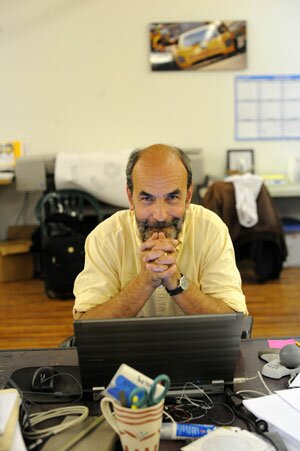
Mechanical engineer Ron Mathis, who has worked on projects for Audi, Jaguar, and Dodge, is Chief of Design for Edison2 and the man behind much of the design of the Very Light Car.
JEN FARIELLO
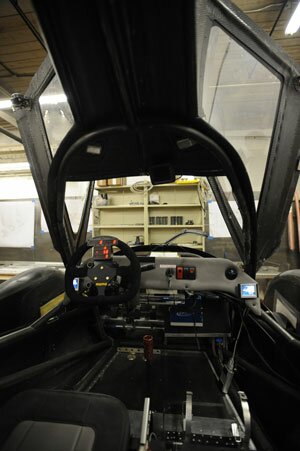
The four-seater version of the car offers ample leg room in both front and rear seats. Cameras take the place of side mirrors, which Kuttner says add wind drag and reduce fuel efficiency.
JEN FARIELLO
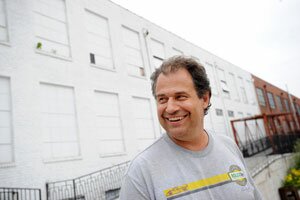
There are no clues that a high tech car company is housed inside this Lynchburg warehouse.
JEN FARIELLO
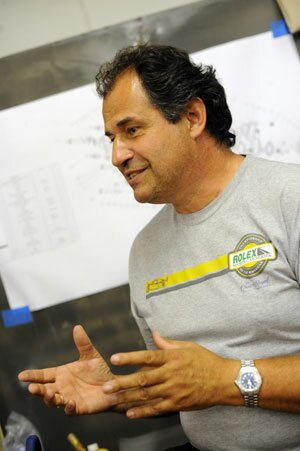
For traditional gas guzzling vehicles, "the BP oil spill is the nail in the coffin," says Kuttner.
JEN FARIELLO
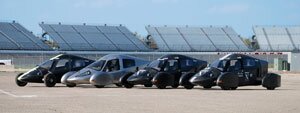
In addition to standard safety features like airbags, required in all vehicles, the Very Light Car's diamond shape is critical, says Kuttner, not only for aerodynamics but also for safety because in a head-on collision, the VLC is far more likely to deflect impact than absorb it directly. Protruding wheels with aerodynamic covers also provide some protection in a side collision.
BRAD JAEGER/EDISON2

Every piece of the Very Light Car lives up to its name. For instance, while traditional suspension systems weigh as much as 100 pounds, the equivalent equipment on the VLC weighs just six and a half pounds.
JEN FARIELLO
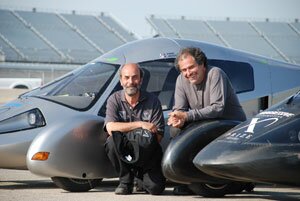
"Our 'a-ha' moment came when we realized we could assume nothing," says Kuttner, right, with Ron Mathis. When it came to alternative fuel vehicles, Kuttner says, "We realized even the experts don't always know what they're talking about." Edison2 settled on fossil fuel after considering the alternatives.
BRAD JAEGER/EDISON@
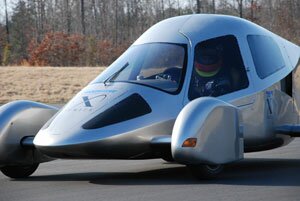
"It's a dream to drive," says Edison2 driver and engineer Brad Jaeger, who races Indy cars professionally. "It's like skiing– it becomes an extension of your body."
NATE THOMPSON
#